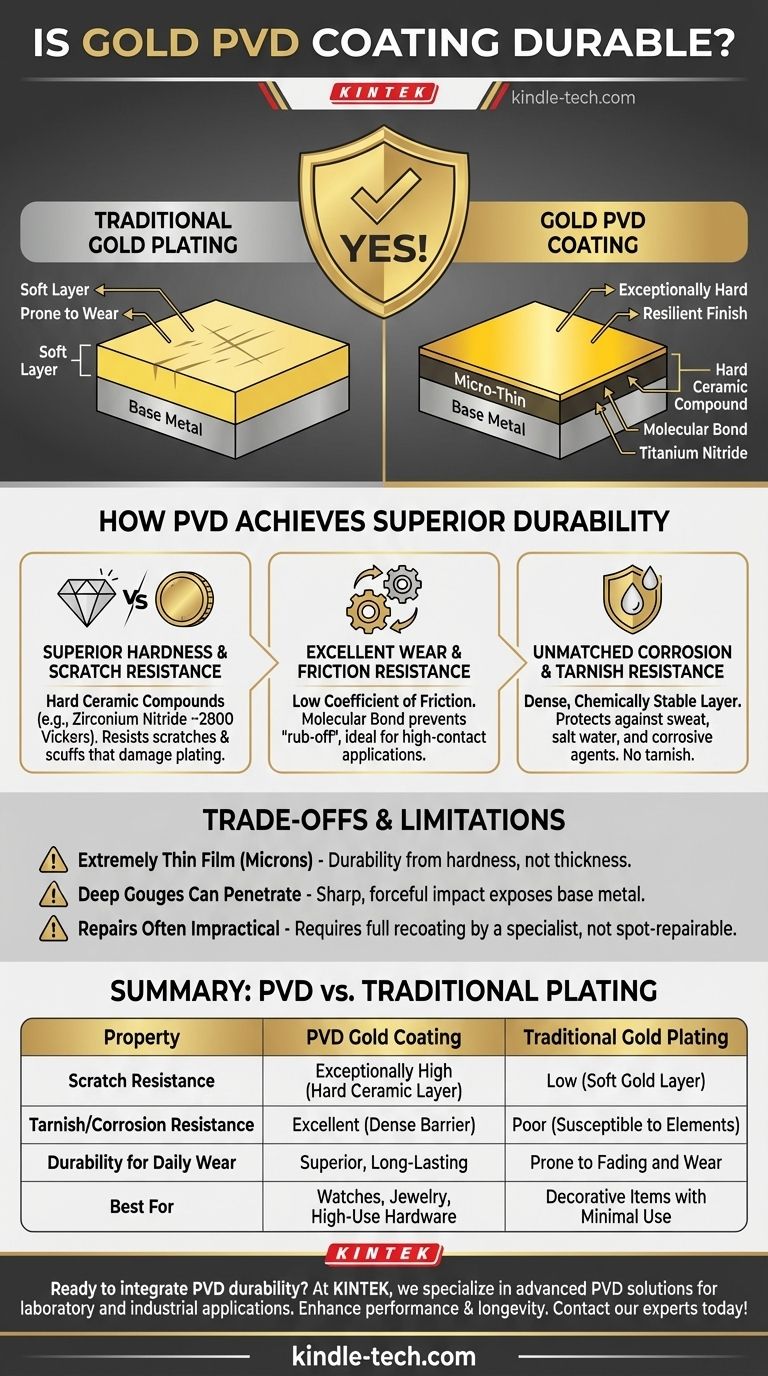In short, yes. Gold Physical Vapor Deposition (PVD) coating is exceptionally durable and represents one of the most resilient gold-colored finishes available today. It is significantly more resistant to scratches, wear, and corrosion than traditional gold plating, making it a superior choice for items that see frequent use.
The key to understanding PVD's durability is realizing it is not a layer of soft gold. Instead, it is a micro-thin layer of a super-hard ceramic compound, like titanium nitride, bonded to the base metal at a molecular level, which is then given a gold color. Its strength comes from the ceramic, not the gold.

How PVD Achieves Its Durability
PVD is a high-tech vacuum coating process. It works by vaporizing a solid material (like titanium nitride) in a vacuum chamber and depositing it onto the surface of a product. This process creates a molecular bond between the coating and the substrate, resulting in a finish that is part of the surface, not just painted on top.
Superior Hardness and Scratch Resistance
The ceramic compounds used in PVD are incredibly hard. For example, some finishes utilize Zirconium Nitride, which has a hardness of around 2800 Vickers—making it substantially harder than traditional chrome.
This extreme surface hardness is what provides its primary defense against daily wear and tear. It effectively resists the minor scratches and scuffs that would quickly damage a traditional gold-plated finish.
Excellent Resistance to Wear and Friction
PVD coatings possess a very low coefficient of friction and are highly resistant to being "rubbed off." This is why they are used not just for decorative items like watches and faucets, but also for functional components and precision tools that endure constant contact.
Unlike gold plating, which is a soft layer that can wear away over time, the PVD coating's molecular bond keeps it firmly adhered to the surface, even in high-contact applications.
Unmatched Corrosion and Tarnish Resistance
The PVD process creates a dense, chemically stable layer that acts as a powerful barrier against the elements. It protects the base metal from sweat, salt water, and other corrosive agents that would cause traditional gold finishes to tarnish or degrade.
This makes PVD an ideal choice for products frequently exposed to harsh environments, such as watches, jewelry, or coastal home hardware.
Understanding the Trade-offs and Limitations
While PVD is remarkably tough, it is not indestructible. Objectivity requires acknowledging its limits.
It Is Still a Thin Film
The PVD coating, despite its hardness, is extremely thin—often only a few microns. Its durability comes from its hardness and bond strength, not its thickness.
Deep Gouges Can Penetrate the Coating
A sharp, forceful impact or a deep, abrasive scratch from a harder material can still penetrate the PVD layer and expose the base metal underneath. The finish protects against wear, not against all possible damage.
Repairs Are Often Impractical
If a PVD coating is significantly damaged, it cannot be spot-repaired or polished out like solid gold. The entire component would need to be stripped and recoated by a specialist, which is often not feasible or cost-effective.
Making the Right Choice for Your Goal
Your decision to choose PVD should align with the product's intended use and your long-term expectations.
- If your primary focus is a durable, everyday gold look: PVD is the best choice for items like watches, jewelry, or faucets that need to withstand daily life without scratching or fading.
- If your primary focus is longevity in a harsh environment: PVD's corrosion resistance makes it the definitive option for hardware near the coast or items with high skin contact.
- If your primary focus is a long-term precious metal investment: Solid gold is the standard, as its value is intrinsic and it can be repaired, whereas PVD is a surface treatment designed for performance.
Ultimately, choosing a PVD-coated product is an investment in a lasting, resilient finish that keeps its appearance far longer than any traditional plating.
Summary Table:
| Property | PVD Gold Coating | Traditional Gold Plating |
|---|---|---|
| Scratch Resistance | Exceptionally High (Hard Ceramic Layer) | Low (Soft Gold Layer) |
| Tarnish/Corrosion Resistance | Excellent (Dense Barrier) | Poor (Susceptible to Elements) |
| Durability for Daily Wear | Superior, Long-Lasting | Prone to Fading and Wear |
| Best For | Watches, Jewelry, High-Use Hardware | Decorative Items with Minimal Use |
Ready to integrate the superior durability of PVD coatings into your products? At KINTEK, we specialize in advanced PVD solutions for laboratory and industrial applications. Our expertise ensures your equipment and components benefit from a finish that is exceptionally resistant to wear, corrosion, and tarnishing.
Enhance the longevity and performance of your products—contact our experts today to discuss your specific needs!
Visual Guide

Related Products
- Custom CVD Diamond Coating for Lab Applications
- RF PECVD System Radio Frequency Plasma-Enhanced Chemical Vapor Deposition RF PECVD
- Electron Beam Evaporation Coating Oxygen-Free Copper Crucible and Evaporation Boat
- Vacuum Hot Press Furnace Machine for Lamination and Heating
- Gold Disc Electrode
People Also Ask
- What is diamond coating film? A Thin Layer of Diamond for Extreme Performance
- How thick is CVD diamond coating? Balancing Durability and Stress for Optimal Performance
- Is diamond coating permanent? The Truth About Its Long-Lasting Durability
- What is CVD diamond coating? Grow a Super-Hard, High-Performance Diamond Layer
- What are diamond coated films? Enhance Materials with Super-Hard, Transparent Layers



















